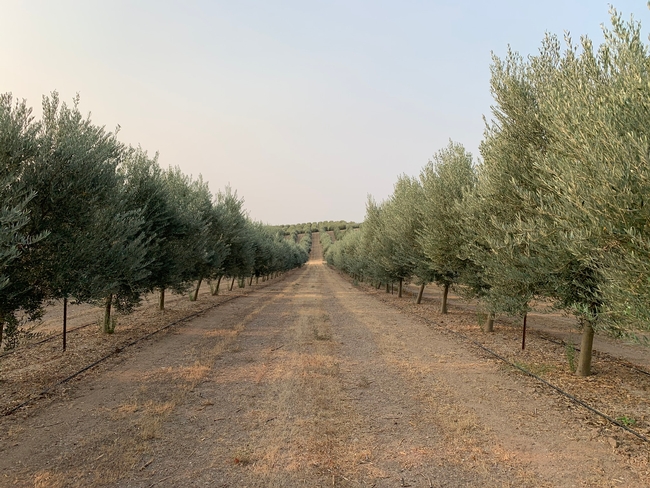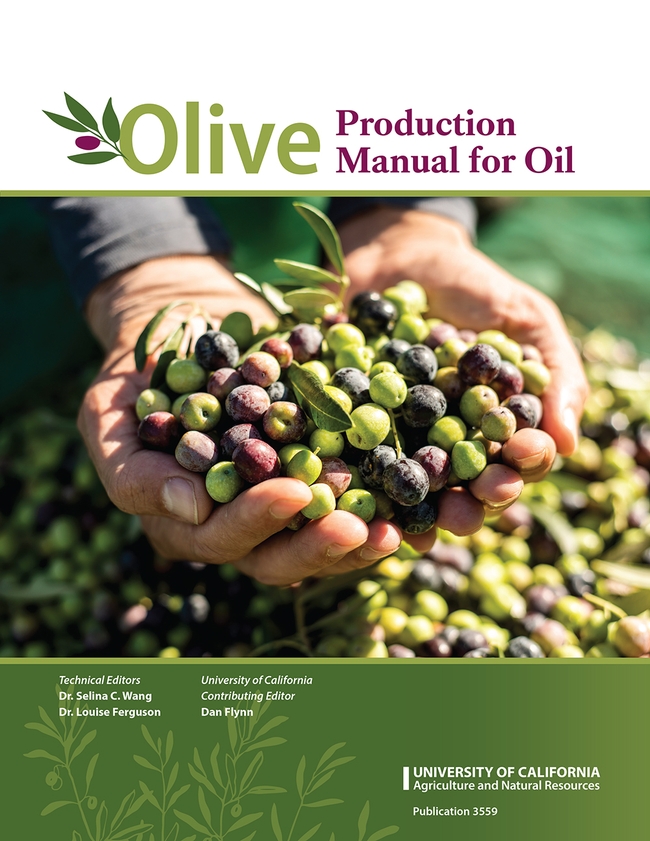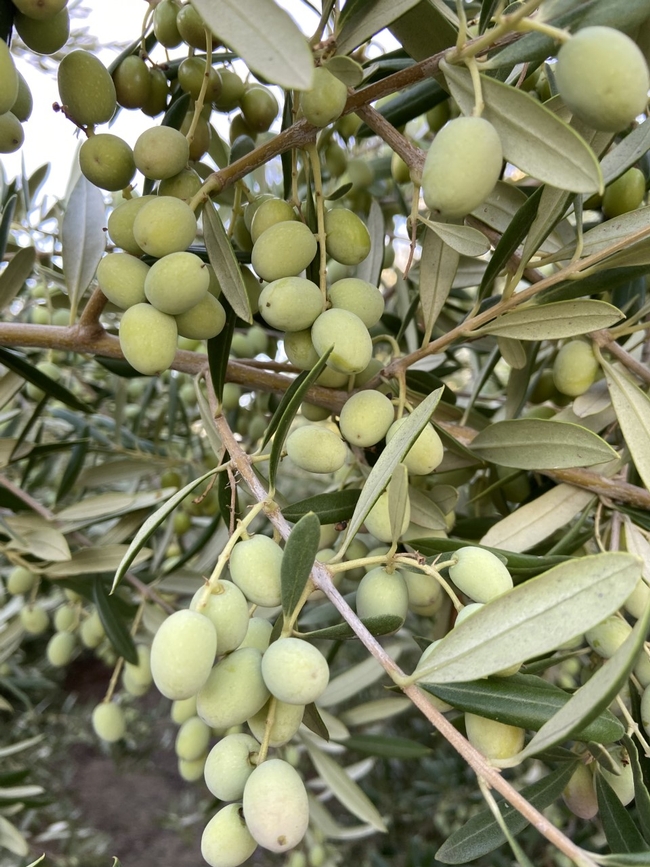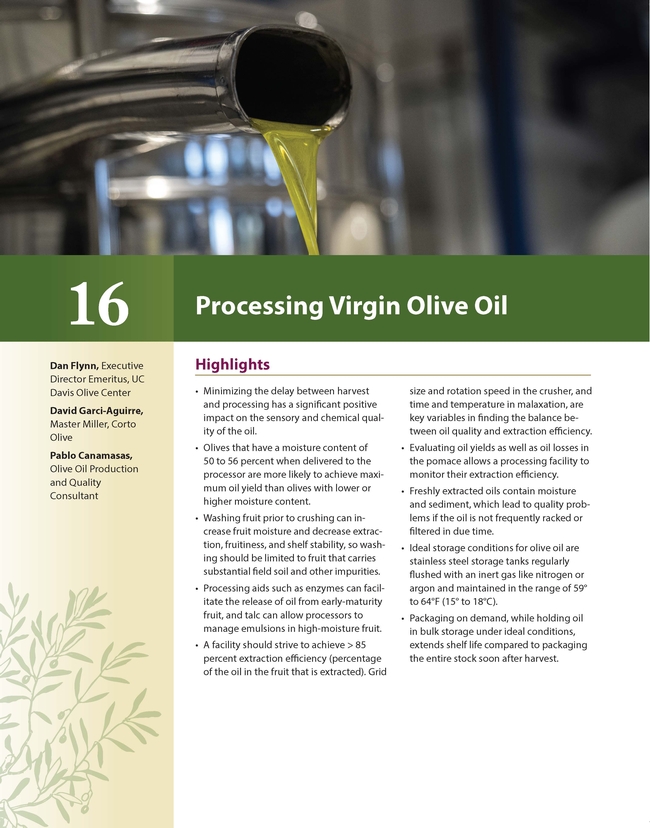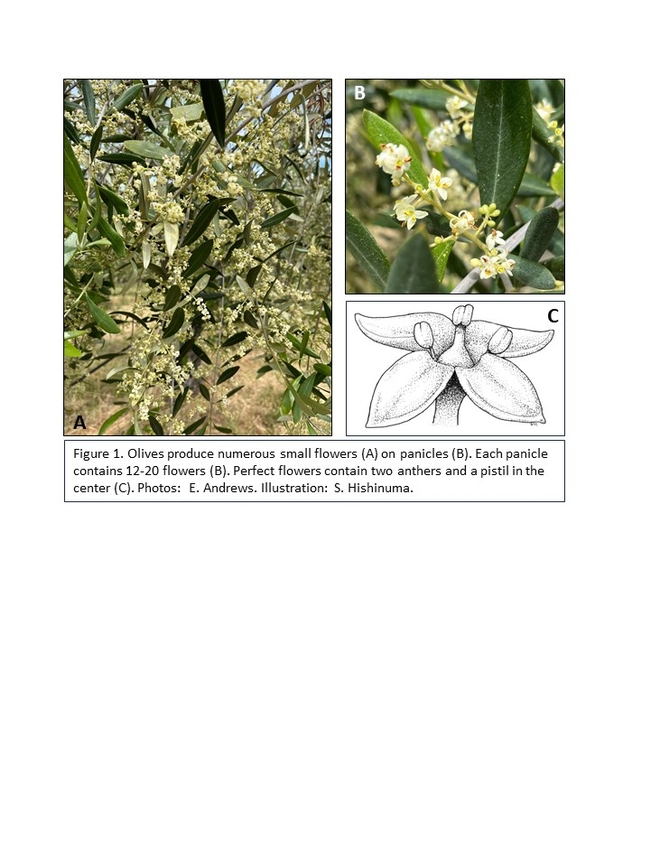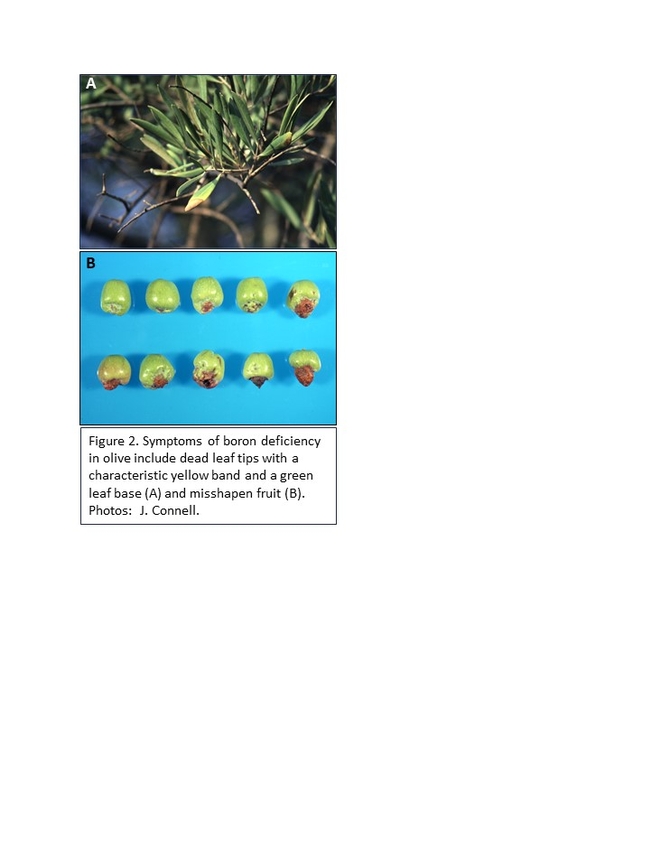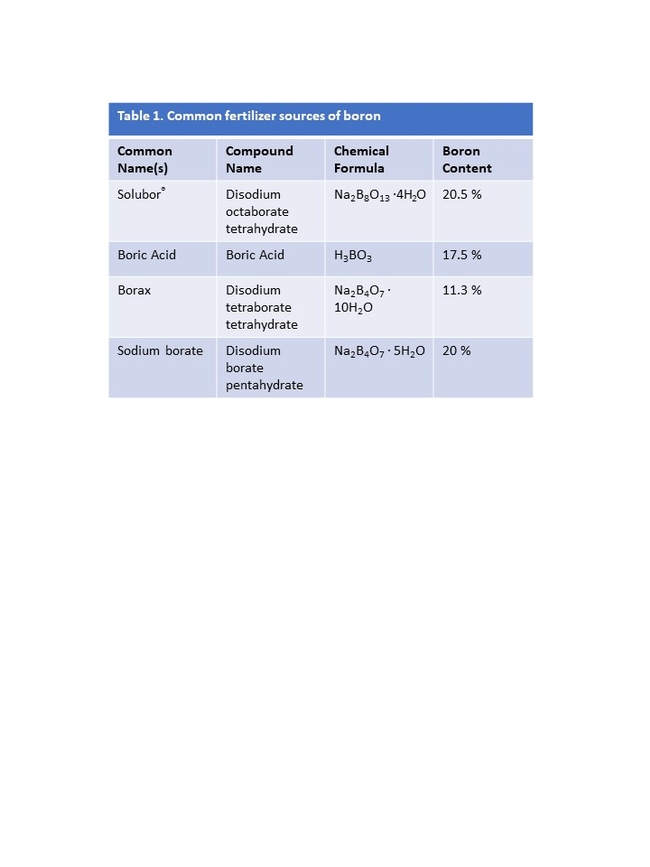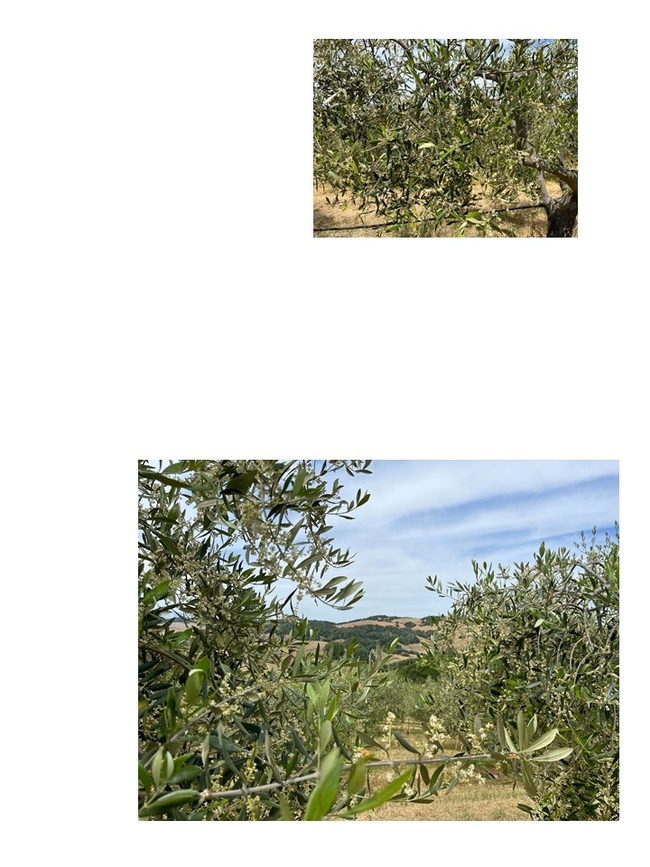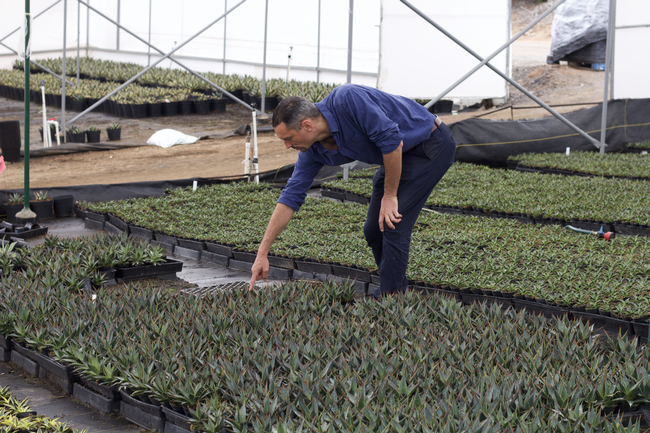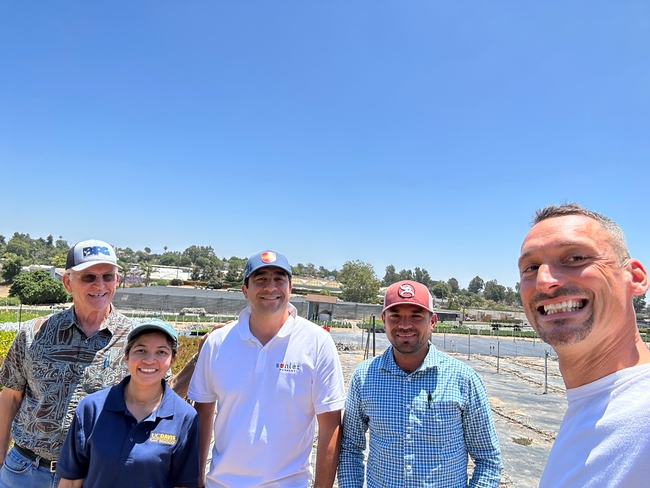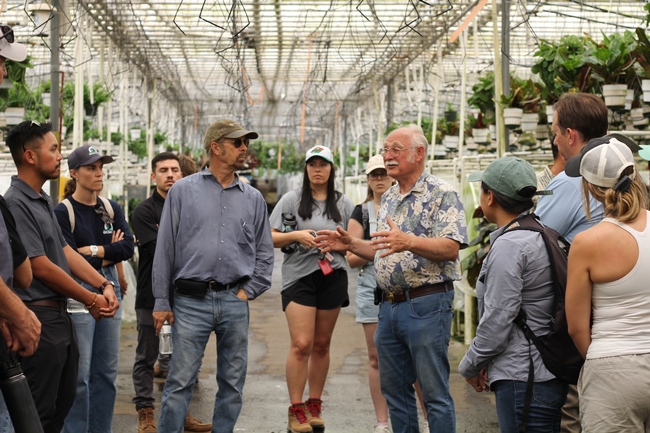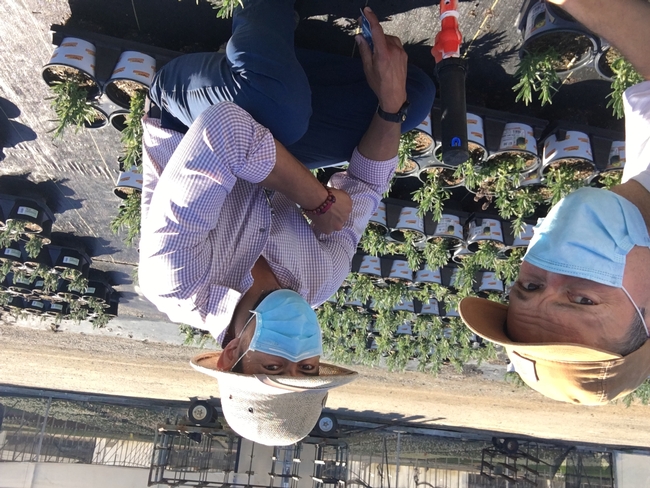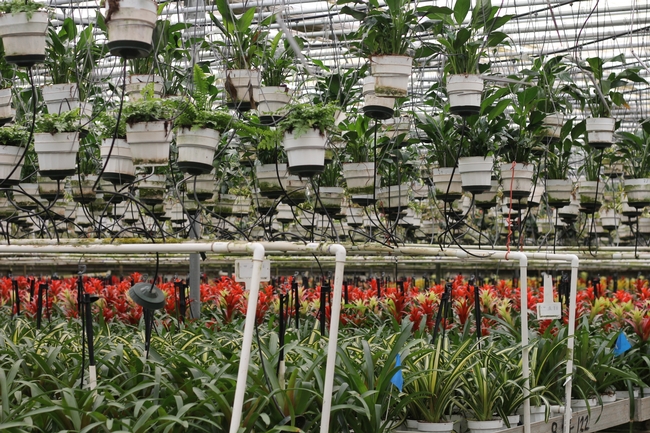Posts Tagged: olive
UC ANR publishes first-ever manual on olive production for oil
Growers, UC Cooperative Extension researchers offer guidance on producing high-quality olives
Facing a deluge of lower-price products from Europe, the California olive oil industry is doubling down on its clear-cut competitive edge: the consistent and bona fide quality of its oil.
“Olive Production Manual for Oil,” a new book published by University of California Agriculture and Natural Resources, aims to help California olive growers maximize that advantage.
“It's a tough market to compete in, but I think the way to win for California is to compete on quality,” said book co-editor Selina Wang, a UC Cooperative Extension specialist in the UC Davis Department of Food Science and Technology. “The quality of California olive oil is unmatched, but you can't make good quality olive oil with bad fruit, so the goal is to get more fruit from the trees – and for the fruits to be high-quality fruit.”
The 273-page manual, available for purchase online, is the first of its kind in the U.S. While some parts of the book are specific to California (which grows nearly all of the olives for domestically produced olive oil), most of the material would be useful to producers in other states, Wang noted.
“Through our conversations with growers, it became clear to us that a manual like this – not a scientific publication but a manual that is easy to follow, written in language that is accessible, and with pictures and illustrations – would be really helpful to the growers,” she said.
Growth of California olive oil industry necessitated creation of manual
Aside from a book focused predominantly on table olives and another on organic olive production (by UCCE farm advisor emeritus Paul Vossen), there was no one-stop, comprehensive resource on the bookshelf for oil olive growers. The need for such a manual had become more acute as oil olives replaced table olives in California orchards during the last 20 years.
Whereas harvesting by hand was historically cost-prohibitive, the introduction of super-high-density planting systems in 1999 made oil olive production more economically feasible. Mechanical pruning and harvesting of new cultivars (Arbequina, Arbosana and Koroneiki) – specifically bred for these densely planted orchards – led to the rapid expansion of oil olives in the state. According to a U.S. Department of Agriculture report, California olive oil production jumped from 2 million pounds in 2006 to an average of 21 million pounds in 2021–23.
With about 37,000 acres of oil olives planted across California, the Olive Oil Commission of California saw the need to support the production of this manual. Championed by Dan Flynn, founder and executive director emeritus of the UC Davis Olive Center, Wang and co-editor Louise Ferguson outlined the contents of the book. They then sought out a mix of growers and industry professionals and UCCE advisors and specialists to write its chapters.
“Most of the information is data-based, from people who are working with the olives,” said Ferguson, a UC Cooperative Extension pomologist at UC Davis. “This is the first data-based olive oil production manual we've had.”
Manual infused with firsthand insights, practical recommendations
Hard-earned experience taught growers a valuable lesson that is conveyed in the book – the need to hand-prune. While mechanical pruning helps control the size of the trees, some hand-pruning is still required to allow light to filter to the leaves. Failing to do so leads to a dramatic decrease in yield.
“That happened in many of the orchards that were inexperienced in these new cultivars and new super-high-density planting systems,” Ferguson said.
She added that other key topics in the manual include irrigation management in a water-constrained state, nitrogen management, harvest timing and orchard site selection. Choosing a good spot for planting is crucial in this era of extreme climate volatility, Ferguson noted, as olive trees are significantly affected by temperature shocks in spring (fruit set) and fall (harvest).
For Wang, another overarching theme in the manual is the importance of testing. Testing the soil, water and leaves provides critical data that growers can use to adjust their inputs and production practices for optimal profitability.
“You may spend a couple hundred dollars on the lab work, but it will pay off, for sure – you're going to increase the health and productivity of your trees,” Wang explained. “Oil olive growers are paid based on the oil content in their fruit; you not only want to have a lot of fruit on the trees, you want to make sure that your fruit are accumulating oil.”
California oil olive growers, practices continue to evolve
Wang and Ferguson hope their book will help California producers compete more effectively in the global marketplace. Currently, about 90% of the olive oil consumed in the U.S. is imported from Mediterranean countries, due primarily to the lower price point. In that region, producers tend to harvest riper olives that produce oil at a greater volume but lesser quality.
In contrast, California growers harvest earlier and produce oil that is higher quality (with more flavor and more antioxidants) and far exceeds accepted standards for “extra virgin olive oil.”
According to Wang, California olive oil mills have nearly maximized their efficiency, and the growth opportunity for the industry is in the orchards: to optimize practices to produce more fruit, and to plant more trees. Wang said the new manual can help on both fronts.
“Just like for other crops, focusing on quality – while increasing efficiency and productivity, and therefore profitability – is the name of the game,” she said.
Ferguson also stressed that knowledge continues to evolve and urged growers to reach out to the editors and chapter authors with their experiences.
“Most of the authors are in California and they're working,” she said. “So if you start to notice things that are different, or you want more information or something is not clear, the authors are available.”
The manual can be purchased at https://anrcatalog.ucanr.edu/Details.aspx?itemNo=3559.
Lawn-pocalypse! Surviving Drought
Ah, summer! The season of sunburns, pool parties, and… lawn droughts. If your once lush, green carpet now looks like a crunchy brown doormat, you're not alone. Let's dive into why your yard is staging a dramatic death scene and what you can do to...

Bermuda grass and weeds overtaking drought stressed turf grass.
Boron on Olives?
Pre-bloom foliar boron application on olive
may improve yield
Ellie Andrews, PhD, UCCE Farm Advisor, Sonoma County, and Elizabeth Fichtner, PhD, UCCE Farm Advisor, Tulare County
Olive orchards entering an OFF year in 2024 may benefit from pre-bloom foliar boron (B) applications to support reproduction and yield. Because the 2023 California olive crop varied widely both within and between olive-growing regions, the value of boron applications should be considered at the individual orchard level. For example, in the southern San Joaquin Valley, the 2023 ‘Manzanillo' table olive crop was OFF due to the high temperatures at bloom whereas many oil cultivars in the region were unaffected by the heat and had heavy production. Those orchards that had a heavy ON crop in 2023 may benefit from pre-bloom boron application in the 2024 season.
Boron is an essential micronutrient for plant growth and reproduction. Boron deficiency affects plant reproduction by reducing pollen viability and germination and limiting pollen tube growth. Deficiency also limits the proportion of flowers that set fruit and reduces the retention of developing fruit. The influence of boron deficiency on multiple stages of reproduction may negatively impact yield. Boron also plays a role in vegetative growth and metabolism, ensuring cell wall and membrane integrity and facilitating sugar transport and cell division. Because boron plays a crucial role in reproduction, boron is translocated from vegetative tissues to reproductive tissues resulting in higher concentrations of the nutrient in reproductive organs than leaves. Due to this high demand, reproductive boron deficiency can occur even when vegetative boron and available soil boron are sufficient.
Studies conducted across numerous global olive-growing regions demonstrate the beneficial effects of foliar boron application on yield, particularly in advance of an OFF crop. The influence of boron application on productivity in olive orchards may relate to increases in photosynthesis, an increase in the number of perfect flowers (those with both male and female reproductive parts) (Figure 1), and an increase in pollen viability, or pollen tube growth. Olives are considered andromonoecious, a reproductive strategy in which plants bear both hermaphroditic (perfect) flowers and male flowers. Stress prior to bloom may cause pistil abscission in a fraction of buds resulting in a higher percentage of male flowers. Several research studies have demonstrated that pre-bloom foliar boron application can increase the percent of perfect flowers on trees, thus increasing the number of flowers capable of producing fruit. In olive, boron is readily mobilized from both young and old vegetative growth to support flower and fruit production; therefore, a portion of boron applied throughout the year may be utilized to support reproductive processes. During the pre-bloom season, however, cool temperatures and the corresponding reduced physiological activity may limit the uptake and translocation of boron in olive. Additionally, flowers are not as strong a boron sink as fruit; therefore, the pre-bloom foliar application may render the micronutrient available at a short-lived, yet critical, time in crop development.
Both oil olives and ‘Manzanillo' table olives have been shown to benefit from foliar boron applications. For example, ‘Arbequina' receiving pre-bloom foliar application of boron exhibited increased bloom and a 27% increase in yield in an OFF year. In the ‘Arbequina' study, no value of boron was observed in an ON year, and boron was found to have no effect on vegetative growth. In another study, boron applications to ‘Frantoio' resulted in increased concentration of chlorophyll and soluble sugars, as well as changes in the profile of endogenous plant growth regulators within the leaves. In California, pre-bloom boron applications on ‘Manzanillo' resulted in increased percentage of perfect flowers and improved fruit set and yield, particularly during an OFF year.
The recommended foliar boron concentration for olives ranges from 19-150 ppm. Values below 14 ppm boron may result in boron deficiency, whereas values above 185 ppm may result in boron toxicity. A foliar nutrient analysis only provides a snapshot of the status of the plant at the time of leaf collection; however, low boron status of leaves has been found to correlate well with symptoms of deficiency. Symptoms of boron deficiency in olive include dead leaf tips with a characteristic yellow band and green leaf base, as well as twig and limb dieback (Figure 1). Boron deficiency may first become apparent in the meristems, the growing tips of shoots. Boron deficiency may also result in misshapen and defective fruit (Figure 1), low fruit set, and premature fruit drop. The value of boron application for improved fruit set is not limited to orchards with visual symptoms of boron deficiency or foliar boron levels below the recommended range. In fact, the numerous research studies that demonstrate the value of pre-bloom foliar boron applications for enhanced fruit set and yield were conducted in orchards with no boron deficiency. Based on these findings, foliar analysis alone may not be a useful predictor of benefits from pre-bloom foliar boron application.
Boron is typically introduced to orchards either as a solid mineral broadcast on the soil surface, or in solution as a foliar spray. The pre-bloom foliar application is designed to specifically enhance fruit set and yield and should be applied three weeks prior to bloom. Boron is generally sold as borax, sodium borate, sodium tetraborate, boric acid, or Solubor® (Table 1). The boron content varies between formulations; therefore, all calculations should be based on the equivalents of active ingredient (ie. pounds of boron). For example, for soil-applied boron in olive, 5-10 lbs/acre of boron is broadcast, which equates to approximately 45-49 lbs/acre of borax (11% boron) or 24-48 lbs/acre Solubor® (20.5% boron). In California, foliar application of boron three weeks prior to ‘Manzanillo' bloom, particularly in OFF years, at rates of 1 or 2 lb./acre Solubor® in a 100 gallon/acre (246 or 491 mg/L boron at 935 L/hectare) was demonstrated to improve yield by approximately 30%. The baseline boron level in this California study site was 16 ppm boron, a level just below the established critical level, but high enough to avoid deficiency symptoms.
The value of boron applications on orchard health and economic return varies based on the status of the alternate bearing cycle in the year of application, the baseline boron status of the tree and soil, and other climate factors that may influence yield. Plants have a narrow range between boron deficiency and toxicity. Be sure to read the product label carefully to avoid over-application and conduct annual leaf tissue analyses to gather baseline information on the boron status of orchards. More information on fertilizer rates for olives and other California crops may be found on the CDFA FREP California Crop Fertilization Guidelines website (https://www.cdfa.ca.gov/is/ffldrs/frep/FertilizationGuidelines/).
UCCE San Diego advisor educates growers on complex water regulations
‘Ag Order' for San Diego County expected to be enforced by end of 2023
Generally known for its steady warmth and picturesque beaches, San Diego County is also home to nearly 5,000 small farms and is an economic hotspot for nurseries and floriculture. But the great diversity of ornamental crops that dominate the growing region and complexity of regulations make compliance challenging for growers, some of whom grow over 400 crop varieties.
“The regulatory environment for the growers is still complicated and overwhelming because, along with the Regional Water Board, growers are regulated by the County of San Diego,” said Gerardo “Gerry” Spinelli, University of California Cooperative Extension production horticulture advisor for San Diego County.
To help growers with compliance, Spinelli is prioritizing education and expanding growers' knowledge. By partnering with organizations such as the Farm Bureau of San Diego County and the San Diego Region Irrigated Lands Group, Spinelli works to reach more than 1,200 growers, supporting them as they navigate regulatory agencies.
Formally referred to as the Regional Water Quality Control Boards, the Regional Water Board aims to develop and enforce water quality objectives and implement plans to protect the beneficial uses of California's waters.
A unique place to grow in California
About 10 years ago, the Regional Water Board created the Agricultural Order (Ag Order), a set of rules outlining how growers manage water discharge from agricultural operations.
The new Ag Order for San Diego County, expected to be enforced by the end of 2023, will focus on nitrogen management and groundwater quality. However, new considerations are needed to address the variety of crops grown by a single farmer, a common practice in San Diego.
Calculating nitrogen input and output for more than 400 crop varieties is not feasible for small farmers, a challenge exacerbated by the meticulous attention needed for San Diego's high-end specialty crops like ornamentals, native plants and specialty fruit.
Furthermore, many San Diego growers have limited expertise and experience because they are entering agriculture as a second or third career. Many have become “accidental growers” in that they purchased land with a preexisting avocado or cherimoya grove, for example.
To help address these challenges, the grower community is emphasizing the need for more educational opportunities that are accessible and relatable.
Equipping growers through education
Enrico Ferro, president of the San Diego Region Irrigated Lands Group – a third-party entity that manages water sample testing on behalf of growers – has relied on Spinelli's teaching to “bridge the gap” for growers, including himself.
“Gerry has been great because he has expertise in nurseries, but the educational content he creates is relevant to all growers,” said Ferro, who is an avocado and citrus grower in San Diego's North County.
Spinelli, who specializes in containerized production in nurseries and floriculture, has been instrumental in providing technical assistance to growers since he joined Cooperative Extension in 2020.
“I started teaching over Zoom since I became an advisor during the pandemic, and I try to cover different topics for each training,” Spinelli said, adding that he teaches in English and Spanish, making his content more accessible to the grower community in San Diego.
For in-person educational opportunities, Spinelli created the “Last Wednesday” monthly meetings hosted at the Farm Bureau of San Diego County, which brings together growers and other agricultural experts to learn from one another.
“We try to get our information out in creative ways and Gerry is instrumental in that. He's our primary source of really wonderful information delivered in an engaging way,” said Tasha Ardalan, program coordinator for the SDRILG. “He's proactive and is always willing to try new things, too.”
Planning for San Diego's agricultural future
Currently, the Ag Order is modeled around regulations for the Central Valley. As conversations and planning for San Diego County continue, Spinelli is supporting the Regional Water Board with information on nurseries and greenhouses in hopes that the final Ag Order will better serve San Diego growers.
“I'm trying to help others understand how nursery and greenhouse production systems function, and how and why they are different from an almond orchard or tomato field in Fresno,” explained Spinelli.
Michael Mellano, CEO of Mellano & Company, a fresh cut flower grower and distributor in Oceanside, feels the impact of the Ag Order and its failure to account for variability. Growing over 100 varieties of flowers, Mellano said that for several plants there is little scientific research on how much nitrate to apply.
“Farmers want to do a good job. We make mistakes and we try to fix them as quickly as we can, and we try to educate others on what works,” said Mellano, who is also a member of the SDRILG.
Growers like Mellano and Ferro agree that the farming community in San Diego needs to be given the latitude to solve problems within their means, an ability that requires an understanding of San Diego's uniqueness.
“San Diego is significantly different, and we need an Ag Order that is reflective of our differences,” said Valerie Mellano, SDRILG consultant and former UCCE environmental issues farm advisor. “In developing the new Ag Order, there's a huge opportunity for education and research, something that we know Gerry can easily do and continue to support us in.”
Thus far, Spinelli's educational content has reached two-thirds of SDRILG's 1,200 members. In addition to the live training sessions, growers can watch videos that cover topics such as evapotranspiration, irrigation distribution uniformity, water quality indicators and more on Spinelli's YouTube channel.
Since the Ag Order requires all growers to complete two hours of water-quality education, the SDRILG has agreed to apply one hour of credit to growers who attend a one-on-one session with Spinelli.
As San Diego's growers continue to leverage educational opportunities – whether it's alongside Spinelli, SDRILG or learning from one another – Spinelli emphasized that their success also relies on an ag order that adheres to a distinctive landscape, multitude of specialty crops and growers with varying expertise.
Climate-Change Resources
University of California UC ANR Green Blog (Climate Change and Other Topics) https://ucanr.edu/blogs/Green/index.cfm?tagname=climate%20change (full index)
Examples:
- Save Trees First: Tips to Keep Them Alive Under Drought https://ucanr.edu/b/~CdD
- Landscaping with Fire Exposure in Mind: https://ucanr.edu/b/~G4D
- Cities in California Inland Areas Must Make Street Tree Changes to adapt to Future Climate https://ucanr.edu/b/~oF7
Drought, Climate Change and California Water Management Ted Grantham, UC Cooperative Extension specialist (23 minutes) https://youtu.be/dlimj75Wn9Q
Climate Variability and Change: Trends and Impacts on CA Agriculture Tapan Pathak, UC Cooperative Extension specialist (24 minutes) https://youtu.be/bIHI0yqqQJc
California Institute for Water Resources (links to blogs, talks, podcasts, water experts, etc.) https://ciwr.ucanr.edu/California_Drought_Expertise/
UC ANR Wildfire Resources (publications, videos, etc.) https://ucanr.edu/News/For_the_media/Press_kits/Wildfire/ (main website)
-UC ANR Fire Resources and Information https://ucanr.edu/sites/fire/ (main website)
-Preparing Home Landscaping https://ucanr.edu/sites/fire/Prepare/Landscaping/
UC ANR Free Publications https://anrcatalog.ucanr.edu/ (main website)
- Benefits of Plants to Humans and Urban Ecosystems: https://anrcatalog.ucanr.edu/pdf/8726.pdf
-Keeping Plants Alive Under Drought and Water Restrictions (English version) https://anrcatalog.ucanr.edu/pdf/8553.pdf
(Spanish version) https://anrcatalog.ucanr.edu/pdf/8628.pdf
- Use of Graywater in Urban Landscapes https://anrcatalog.ucanr.edu/pdf/8536.pdf
- Sustainable Landscaping in California https://anrcatalog.ucanr.edu/pdf/8504.pdf
Other (Non-UC) Climate Change Resources
Urban Forests and Climate Change. Urban forests play an important role in climate change mitigation and adaptation. Active stewardship of a community's forestry assets can strengthen local resilience to climate change while creating more sustainable and desirable places to live. https://www.fs.usda.gov/ccrc/topics/urban-forests
Examining the Viability of Planting Trees to Mitigate Climate Change (plausible at the forest level) https://climate.nasa.gov/news/2927/examining-the-viability-of-planting-trees-to-help-mitigate-climate-change/
Reports and other information resources coordinated under the auspices of the United Nations and produced through the collaboration of thousands of international scientists to provide a clear and up to date view of the current state of scientific knowledge relevant to climate change. United Nations Climate Action
Scientific reports, programs, action movements and events related to climate change. National Center for Atmospheric Research (National Science Foundation)
Find useful reports, program information and other documents resulting from federally funded research and development into the behavior of the atmosphere and related physical, biological and social systems. Search and find climate data from prehistory through to an hour ago in the world's largest climate data archive. (Formerly the "Climatic Data Center") National Centers for Environmental Information (NOAA)
Think tank providing information, analysis, policy and solution development for addressing climate change and energy issues (formerly known as the: "Pew Center on Global Climate Change"). Center for Climate & Energy Solutions (C2ES)
Mapping Resilience: A Blueprint for Thriving in the Face of Climate Disaster. The Climate Adaptation Knowledge Exchange (CAKE) was launched in July 2010 and is managed by EcoAdapt, a non-profit with a singular mission: to create a robust future in the face of climate change by bringing together diverse players to reshape planning and management in response to rapid climate change. https://www.cakex.org/documents/mapping-resilience-blueprint-thriving-face-climate-disaster
Cal-Adapt provides a way to explore peer-reviewed data that portrays how climate change might affect California at the state and local level. We make this data available through downloads, visualizations, and the Cal-Adapt API for your research, outreach, and adaptation planning needs. Cal-Adapt is a collaboration between state agency funding programs, university and private sector researchers https://cal-adapt.org/
Find reports, maps, data and other resources produced through a confederation of the research arms of 13 Federal departments and agencies that carry out research and develop and maintain capabilities that support the Nation's response to global change. Global Change (U.S. Global Change Research Program)
The Pacific Institute is a global water think tank that combines science-based thought leadership with active outreach to influence local, national, and international efforts to develop sustainable water policies. https://pacinst.org/our-approach/
Making equity real in climate adaptation and community resilience policies and programs: a guidebook. https://greenlining.org/publications/2019/making-equity-real-in-climate-adaption-and-community-resilience-policies-and-programs-a-guidebook/
Quarterly CA Climate Updates and CA Drought Monitor Maps (updated each Thursday) https://www.drought.gov/documents/quarterly-climate-impacts-and-outlook-western-region-june-2022

